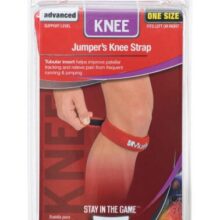Jumper’s Knee Strap
Se connecter pour obtenir les prix des revendeurs
This popular knee strap applies pressure to the patellar tendon to reduce the pain of tendonitis. Available in seven colors and is a one size design.
Osgood-Schlatter Disease is an inflammation of the patellar ligament on the tibia (shinbone) just below the kneecap. People sometimes also refer to it as Osgood Schlatter Syndrome. The most noticeable symptom of Osgood Schlatter Disease is a painful bump on the tibia, just below the knee. It is primarily an overuse injury that affects young athletes in their adolescent years. Osgood Schlatter disease typically goes away after the bones of an affected individual stop growing, so treatment is usually not necessary. However, pain relieving medications can be useful until this happens.
Sports involving extensive running and /or jumping are a risk factor. Basketball, soccer and even tennis are examples. This is so because the underlying mechanism is repeated tension on the growth plate of the upper tibia. Males between the ages of 10 and 15 (growth years) are the most frequently affected demographic.
In young physically active athletes, ativities that require running or jumping cause the quadricep muscles of the thigh to pull on the patellar tendon connecting the kneecap (patella) to the shinbone. The point of attachment of the patellar tendon with the shinbone is called the growth plate. The constant pulling on the growth plate causes pain and swelling below the patella, which is the key symptom of Osgood Schlatter Disease.
For some adolescents with the disease, the body responds to the constant pulling and pressure by generating additional bone mass in the area of the growth plate. This additional bone manifests itself as a bony bump under the patella.
The main symptoms are:
The bony bump below the kneecap may be permanent but in most cases does not interfere with the use of the knee.
Since it usually disappears at the end of the growth years, treatment of Osgood Schlatter Disease is not usually necessary. However, a doctor may suggest using over the counter pain killers to ease the discomfort of the condition.
One treatment option for the condition is to have the child follow an exercise program to stretch his or her quadricep muscles. This can help by reducing the tension exerted on the growth plate below the kneecap. Other exercises can help to strengthen the quadricep muscles and improve knee joint stability, thus reducing the severity of the disease.
A knee strap (or patellar tendon strap) can also help to relieve the pressure on the growth plate.
In cases of continuing severe pain after the child has stopped growing, doctors may recommend surgery to remove the bony bump. However, this is a rare occurrence.

Se connecter pour obtenir les prix des revendeurs
This popular knee strap applies pressure to the patellar tendon to reduce the pain of tendonitis. Available in seven colors and is a one size design.

Se connecter pour obtenir les prix des revendeurs
The McDavid Knee Strap / Patella has a tubular, non-slip buttress that applies constant uniform compression at the patellar tendon. It has an adjustable hook and loop closure for custom fit.
Level 2: Advanced Protection – Reducing symptoms of patellar tendonitis (runner’s/jumper’s knee), Osgood-Schlatter disease and patella tracking

Se connecter pour obtenir les prix des revendeurs
The McDavid Knee Support / Adjustable has movable padded buttresses for added compression and pain relief. There is also an adjustable hook and loop closure for custom fit. The flat-seam construction provides ultra comfort and contouring fit
Level 2: Advanced Protection – Reducing symptoms of patellar tendonitis (runner’s/jumper’s knee), Osgood-Schlatter disease and patella tracking

Se connecter pour obtenir les prix des revendeurs
Petallar tendonitis and osgood-schlatter disease treatment
The BioSkin Q Baby Patella Tendon Strap is an ultra-low profile patella tendon strap constructed from Bio Skin’s micro-fleece-lined Ultima 2SL™ material. The Q Baby wraps comfortably around the knee, just below the patella. The design includes a uniquely shaped silicon pad that fits over the patellar tendon to give compression